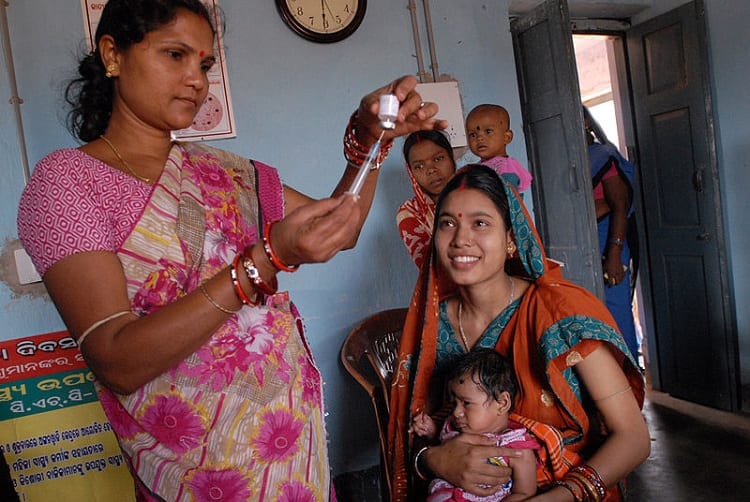
Modicare In India Can Change Lives But Only At The Expense Of Female Healthcare Workers
Lifestyle Feb 18, 2019
A universal healthcare program called the Ayushman Bharat-National Health Protection Mission (AB-NHPM), unofficially dubbed ‘Modicare,’ after Indian Prime Minister Narendra Modi, was introduced in India in September 2018 in 450 districts in India, according to Knowledge @ Wharton. as a way to make healthcare accessible for India’s population. Modicare depends on female healthcare workers, who make up the majority of the healthcare workforce and despite their significance they’re are often placed in precarious positions or are denied fair pay (if they’re paid at all). These issues can pose as a deterrent for women to remain in the workforce, and raise questions about the socio-economic and political controls that are prevalent in Indian culture that work to control women. Modicare in India can change lives but only at the expense of female healthcare workers.
Ayushman Bharat-National Health Protection Mission (AB-NHPM):
The program is intended to provide 500 million individuals with healthcare at no cost, but this is not quite the case. Instead, AB-NHPM will impact the low-income citizens in India, who will be able to access $7,800 (USD) per 100,000,000 people, accordingly to Global Citizen. This is important since poverty affects approximately 73,000,000 people in India, who are each surviving on $1.90 (USD) daily, notes Times of India.
The program will cost about $780 billion (USD), making it the most subsidized healthcare initiative by a government, reports Global Citizen.
Global Citizen explains that India’s government will also be introducing 150,000 health facilities in the countryside to ensure these individuals also have access to healthcare, which will cost approximately $190 million (USD) to fund. The first location was established in April 2018, according to Knowledge @ Wharton.

Challenges:
To function, AB-NHPM requires a large workforce that typically consists of female workers, such as nurses, midwives, and doctors. According to UHC-India, “In India, it is estimated that there are seven female health workers per 10,000 populations which translates into women comprising one-third of the total health workers in the country [or] 70%.”
These women, who are the backbone of the healthcare industry, especially now with the expansions AB-NHPM will bring about, will be a hurdle for Modicare. To be clear, the women themselves are not the issue, instead, it is the difficulties they face due to the violence they encounter, along with the socio-economic stigmas that are still prominent in Indian culture.
For example, some healthcare workers, such as accredited social health activists (ASHAs) who the government are depending on to spread the word to families who will benefit from Modicare had not been paid for months back in March 2018, reports Down To Earth. ASHAs within rural communities to provide medical assistance to deliver immunization and aid for pregnant women. In fact, some of the 900,000 ASHAs that were awaiting their paychecks, had not been paid since 2017, according to Down To Earth. These women play an important role within these rural communities, by way of delivering injections to combat Tuberculosis and babies, notes The Wire. Thus, although Prime Minister Modi, in 2018, hiked the pay rates for ASHAs, it’s hard to say if this will be enough to continue to entice women to put themselves in dangers way as they commute between postings.

On that note, the violence that female healthcare workers are susceptible to in their line of work can be a deterrent to their choice to continue to work. For instance, healthcare workers in rural areas, such as ASHAs are often assigned to go to distant locations and keep abnormal hours, which leads to them being in vulnerable positions that are often taken advantage of by preying predators. Unfortunately, this is prevalent in India, where there are frequent reports about women being sexually violated in public, indicating there is an overarching problem within Indian culture that needs to be addressed.
The government also needs to crack down on local police stations to ensure they are carrying out the law and holding the guilty party accountable for their action. However, what typically happens it that women who come forward about being sexually assaulted are demonized, ignored, or threatened to ensure they remain silent reports The Wire.

What Changes Are Needed?
Denying women compensation, let alone fair pay, and placing them in dangerous situations works to limit the progression of women within Indian society. For instance, these forms of socio-economic and political control limit the sovereignty and influence women have to challenge the problematic practices or norms that are embedded into the fabric of Indian culture, such as sexual violence.
Part of the change that’s required is to make the lives of female healthcare workers (and other female workers in general) better is that there needs to be female representation, by way of leadership. Currently, according to The Diplomat, “nine out of 10 legislators are men.” Not only do there need to be more women in politics who can put forward agendas and ideas that identify and stand-up for women’s rights and needs, but increased female leadership is required in healthcare as well. This will ensure there is a voice within the healthcare industry that can empathize with and protect female healthcare workers in the industry.

That said, to achieve universal healthcare and provide a thorough service, the Indian government will need to be able to ensure they can maintain a safe and fair working environment for female workers, specifically those in the healthcare industry, given that it relies so heavily on them.
Main Image Photo Credit:www.downtoearth.org.in
Devika Goberdhan | Features Editor - Fashion
Author
Devika (@goberdhan.devika) is an MA graduate who specialized in Political Science at York University. Her passion and research throughout her graduate studies pushed her to learn about and unpack hot button issues. Thus, since starting at ANOKHI in 2016, she has written extensively about many challe...













































































































